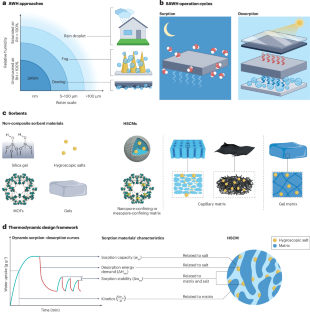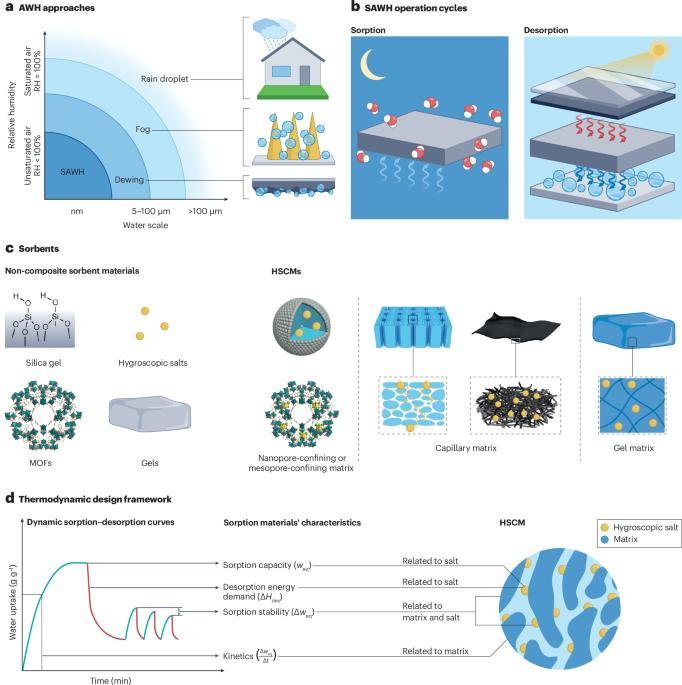用于基于吸附的大气水收集的吸湿性盐嵌入复合材料
IF 79.8
1区 材料科学
Q1 MATERIALS SCIENCE, MULTIDISCIPLINARY
引用次数: 0
摘要
基于吸附技术的大气水收集有可能通过从空气中提取淡水来解决缺水问题。这项技术的性能在很大程度上取决于所使用的吸附剂。吸湿盐嵌入式复合材料(HSCMs)是吸附式大气水收集技术中很有前途的吸附剂,因为它们将吸湿盐在所有相对湿度水平下的高吸附能力与多孔或网络基质的保盐结构和动力学增强特性结合在一起。然而,人们对 HSCM 中基质与盐之间的相互作用尚未完全了解,这阻碍了其吸附性能的合理设计。本综述介绍了一个框架,通过对吸湿盐、水和盐溶液之间的相互作用进行深入的热力学分析,了解 HSCM 的主要吸附特性--容量、焓、动力学和稳定性。利用这一框架,我们对已报道的 HSCM 进行了分析,并通过考虑盐含量、孔隙结构和基质承载能力等因素来指导未来复合材料的设计。我们还研究了吸附和解吸循环中的能量流,以探索基质的潜在设计,从而提高这两方面的性能。展望未来,我们强调吸附剂材料和多功能设备系统同步设计的重要性,将材料设计需求、当地水需求和能源效率结合起来,以充分利用大气湿度尚未开发的功能。本文章由计算机程序翻译,如有差异,请以英文原文为准。


Hygroscopic salt-embedded composite materials for sorption-based atmospheric water harvesting
Sorption-based atmospheric water harvesting has the potential to address water scarcity by extracting fresh water from the air. The performance of this technology largely depends on the sorbent used. Hygroscopic salt-embedded composite materials (HSCMs) are promising sorbents for sorption-based atmospheric water harvesting because they combine the high sorption capacities of hygroscopic salts across all relative humidity levels with the salt-retaining structure and kinetics-enhancing properties of a porous or networked matrix. However, the interactions between the matrix and salts in HSCMs are not yet fully understood, which hinders the rational design of their sorption performance. This Review introduces a framework for understanding key sorption characteristics — capacity, enthalpy, kinetics and stability — of HSCMs, through an in-depth thermodynamic analysis of the interactions among hygroscopic salts, water and salt solutions. Using this framework, we analyse reported HSCMs and guide the design of future composites by considering factors such as salt content, pore structure and the carrying capacity of the matrix. We also examine the energy flow within the sorption and desorption cycles to explore potential designs for the matrix that could enhance both aspects. Looking forward, we emphasize the importance of designing sorbent materials and multifunctional device systems in tandem, integrating material design needs, local water demand and energy efficiency to fully leverage the untapped capabilities of atmospheric humidity. Sorption-based atmospheric water harvesting offers a potential solution to address global water scarcity. This Review provides a framework for guiding future designs of sorbent materials through understanding key sorption characteristics — capacity, enthalpy, kinetics and stability — derived from the thermodynamic analysis of the interactions among hygroscopic salts, water and salt solutions.
求助全文
通过发布文献求助,成功后即可免费获取论文全文。
去求助
来源期刊

Nature Reviews Materials
Materials Science-Biomaterials
CiteScore
119.40
自引率
0.40%
发文量
107
期刊介绍:
Nature Reviews Materials is an online-only journal that is published weekly. It covers a wide range of scientific disciplines within materials science. The journal includes Reviews, Perspectives, and Comments.
Nature Reviews Materials focuses on various aspects of materials science, including the making, measuring, modelling, and manufacturing of materials. It examines the entire process of materials science, from laboratory discovery to the development of functional devices.
 求助内容:
求助内容: 应助结果提醒方式:
应助结果提醒方式:


